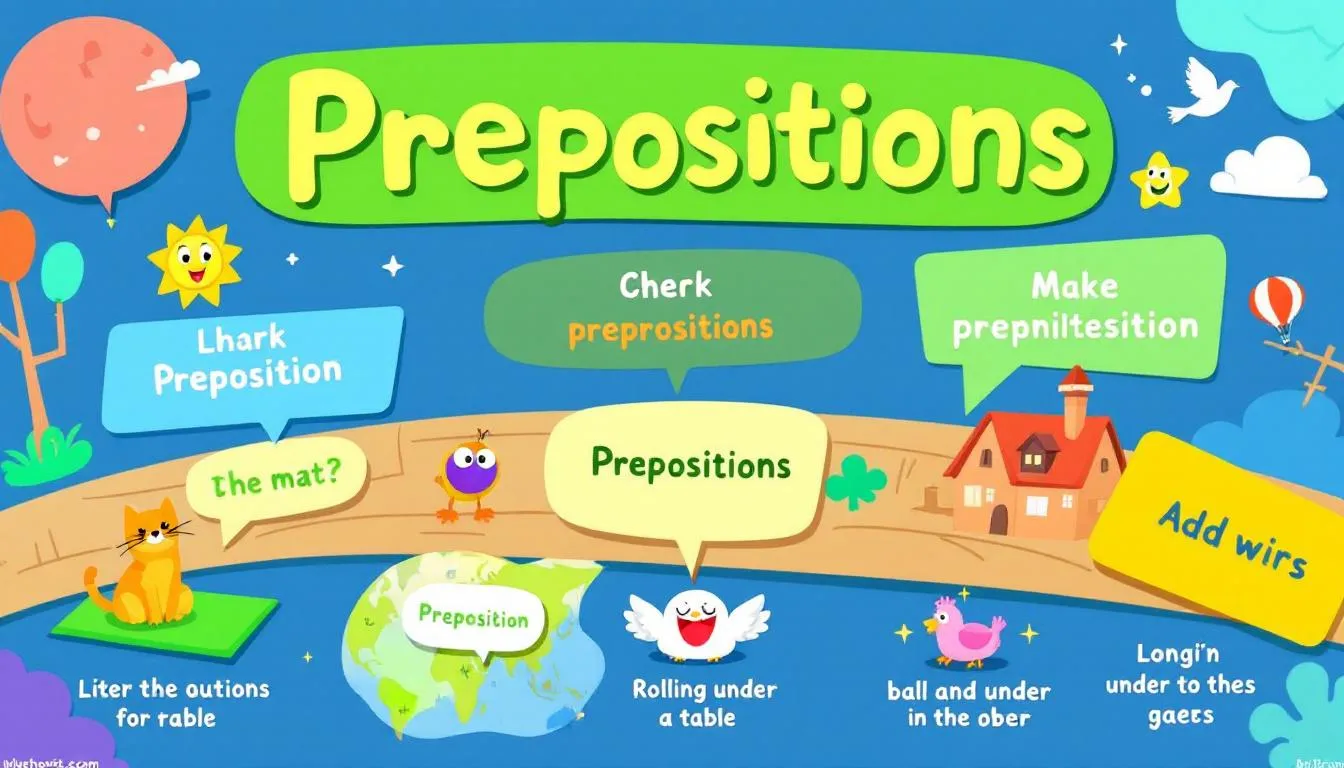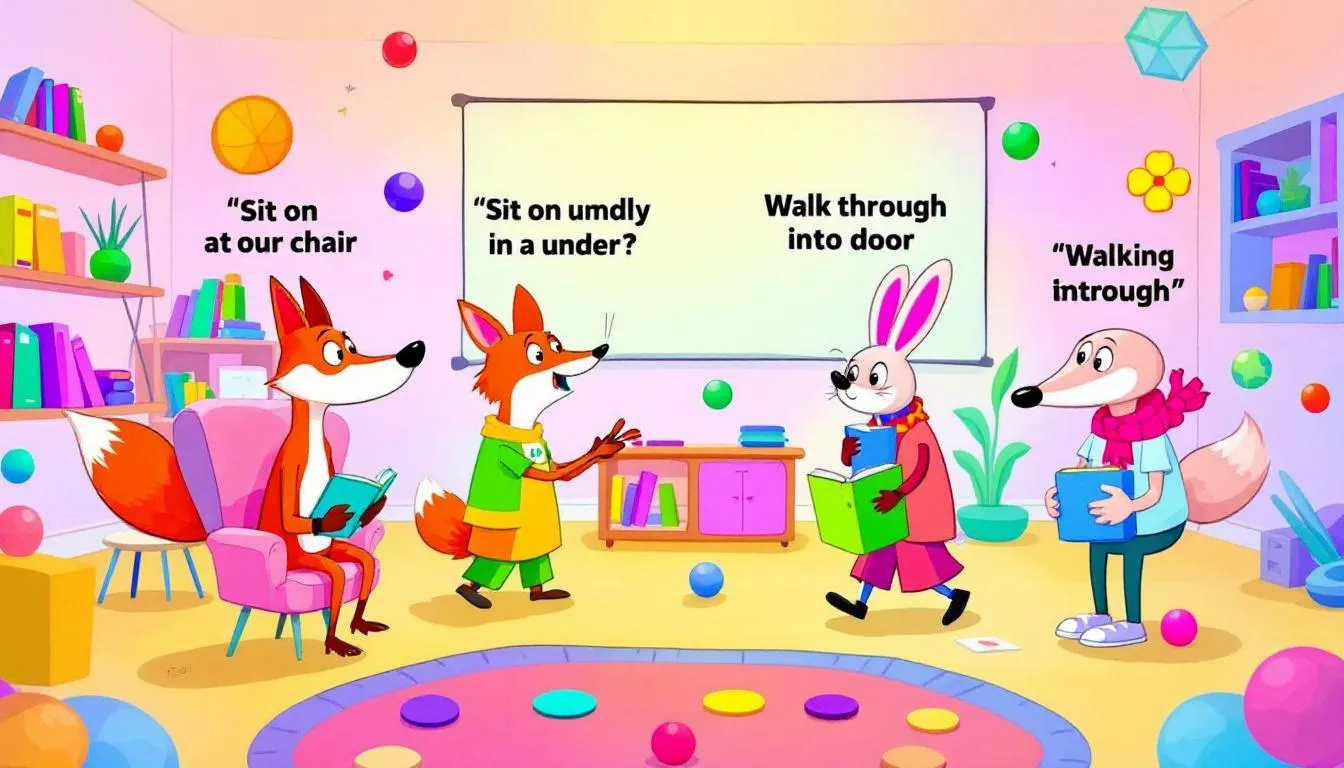Mastering the Preposition: Essential Tips and Examples
Key Takeaways
- Prepositions are essential for expressing relationships in a sentence, including time, location, and direction.
- Understanding the various types and uses of prepositions—such as those related to time, place, and direction—enhances clarity in communication.
- Complex prepositional combinations with nouns, verbs, and adjectives are crucial for precise expression, while consistent practice is key to mastering their usage.
1.Understanding Prepositions
 A preposition is a word that links nouns, pronoun, and phrases, acting as a bridge to connect different parts of a sentence. They are essential in expressing the relationships between various elements within a sentence, such as time, location, direction, and manner. For instance, in the sentence “The book is on the table,” the preposition “on” links the book and the table, indicating their spatial relationship.Prepositions not only link ideas or actions to nouns but also suggest relationships like location and time, which are crucial for clear communication. Commonly used different prepositions include:
A preposition is a word that links nouns, pronoun, and phrases, acting as a bridge to connect different parts of a sentence. They are essential in expressing the relationships between various elements within a sentence, such as time, location, direction, and manner. For instance, in the sentence “The book is on the table,” the preposition “on” links the book and the table, indicating their spatial relationship.Prepositions not only link ideas or actions to nouns but also suggest relationships like location and time, which are crucial for clear communication. Commonly used different prepositions include:- ‘of’
- ‘to’
- ‘for’
- ‘with’
- ‘on’
- ‘at’ These help us express concepts like position, movement, and possession.
2.Common Prepositions and Their Uses
 Common prepositions are the backbone of English sentences, frequently appearing in our daily communication. Words like:
Common prepositions are the backbone of English sentences, frequently appearing in our daily communication. Words like:- above
- across
- against
- along
- among
- around
- before
- behind
- below
- beneath
- beside
- between
- by
- down
- from
- in
- near
- of
- off
- on
- toward
- under
- with
- within are among the most common prepositions used. Interestingly, ‘of’, ‘to’, and ‘in’ rank among the ten most common words in English, highlighting their importance in our language, as they often function as the same preposition.
3.Types of Prepositions
Prepositions are versatile, expressing relationships related to direction, time, and spatial location. They are commonly categorized into four main types:- Time
- Place
- Direction
- Other uses
Prepositions of Time
Prepositions of time are essential in pinpointing when actions occur. Common examples include:- ‘at’: used for specific times, e.g., “at half past seven”
- ‘on’: used for days, e.g., “on Monday”
- ‘in’: used for longer periods such as months and years, e.g., “in 1995”
- ‘before’
- ‘after’
- ‘during’
- ‘throughout’
Prepositions of Place
Place prepositions indicate where something is located. Words like:- ‘in’
- ‘at’
- ‘on’ describe different types of place references. For example, prepositions such as:
- ‘under’
- ‘beside’
- ‘between’ are used to specify locations in relation to other objects or places. These prepositions help us create a vivid picture of where actions and events take place.
Prepositions of Direction
Prepositions of direction denote the path or movement from one location to another, typically used with verbs of motion. Examples include ‘toward’ and ‘across’, which means indicate movement from one form place to another.For instance, the preposition ‘across’ signifies moving from one side to another, as in “She walked across the street”. Meanwhile, ‘through’ indicates moving directly inside something and out the other end, like “The tunnel goes through the mountain”. Understanding these prepositions helps us describe movement and directions accurately.4.Recognizing Prepositional Phrases
 Prepositional phrases start with a preposition and conclude with its object, which may include additional modifiers. Recognizing these phrases involves identifying the preposition and determining the object it connects to. This can enhance our ability to parse sentences and understand their structure.Examples of prepositional phrases include: “at home”, “with a little help”, and “according to their wishes”. These clauses add detail and context, making our sentences more informative and engaging in the following sentences that form phrases.
Prepositional phrases start with a preposition and conclude with its object, which may include additional modifiers. Recognizing these phrases involves identifying the preposition and determining the object it connects to. This can enhance our ability to parse sentences and understand their structure.Examples of prepositional phrases include: “at home”, “with a little help”, and “according to their wishes”. These clauses add detail and context, making our sentences more informative and engaging in the following sentences that form phrases.5.Prepositions with Nouns, Verbs, and Adjectives
Prepositions often follow specific nouns, verbs, and adjectives, forming dependent prepositions that alter their meanings. These combinations are crucial for precise communication, as they convey specific relationships and nuances.Prepositional verbs are verbs linked with prepositions to add meaning. The meaning of a verb can change significantly with a preposition, highlighting the importance of understanding these combinations.Noun-Preposition Combinations
Noun-preposition combinations often indicate relationships such as possession or dependency. For example, ‘depend on’ shows a dependency relationship, meaning that someone or something relies on another. The definition of this relationship highlights its significance.Mastering these combinations can be achieved by reading Standard American English books, journals, and newspapers, which provide numerous examples in context.Verb-Preposition Combinations
A phrasal verb consists of multiple words that function together as a single verb. This combination conveys a specific meaning that is often different from the individual words. Changing the preposition can completely alter the meaning of the phrase, demonstrating how prepositions significantly modify the meaning of verbs.For example, the verb ‘look’ can change meaning depending on the preposition it pairs with: ‘look up’ (to search for information) vs. ‘look after’ (to take care of). This illustrates the dynamic nature of phrasal verbs.Adjective-Preposition Combinations
Adjective-preposition combinations often describe feelings or states related to the adjective. For instance, ‘interested in’ shows a state of interest, while ‘afraid of’ indicates fear. These combinations enhance our ability to express emotions and opinions accurately, describing them effectively.Recognizing and memorizing these confusing combinations helps avoid confusion and ensures correct usage in various contexts.6.Avoiding Common Mistakes
 Ending a sentence with a preposition is often acceptable in informal contexts, contrary to traditional grammar rules. Actually, it’s a myth that this is incorrect. However, overusing prepositional phrases can contribute to wordiness and obscure the sentence’s main point.A common mistake is adding unnecessary prepositions at the end of questions, such as “Do you know where it is at?” which can be tricky to correct to “Do you know where it is?” This is not wrong. Another frequent error is using ‘of’ instead of ‘have’, like “I have a cat” instead of “I have of a cat.”Regular practice through exercises is essential for mastering prepositions. Engaging in practice helps solidify understanding and ensures correct usage in writing and speech. WukongEnglish platform offer a variety of exercises and examples to help learners improve their skills.
Ending a sentence with a preposition is often acceptable in informal contexts, contrary to traditional grammar rules. Actually, it’s a myth that this is incorrect. However, overusing prepositional phrases can contribute to wordiness and obscure the sentence’s main point.A common mistake is adding unnecessary prepositions at the end of questions, such as “Do you know where it is at?” which can be tricky to correct to “Do you know where it is?” This is not wrong. Another frequent error is using ‘of’ instead of ‘have’, like “I have a cat” instead of “I have of a cat.”Regular practice through exercises is essential for mastering prepositions. Engaging in practice helps solidify understanding and ensures correct usage in writing and speech. WukongEnglish platform offer a variety of exercises and examples to help learners improve their skills.Summary
In summary, prepositions are pivotal in linking sentence elements and clarifying relationships. Understanding common prepositions and their uses, recognizing prepositional phrases, and mastering their combinations with nouns, verbs, and adjectives are crucial for effective communication.By avoiding common mistakes and engaging in regular practice, you can enhance your proficiency in using prepositions. Embrace the challenge, and you’ll find that mastering prepositions unlocks a new level of clarity and sophistication in your language skills.Frequently Asked Questions
Can a sentence end with a preposition?
Yes, a sentence can end with a preposition; this is considered acceptable in informal contexts and can sound more natural in conversation.What are some common mistakes with prepositions?
Common mistakes with prepositions often involve overusing prepositional phrases, adding unnecessary prepositions, and incorrectly substituting ‘of’ for ‘have’. It is essential to use prepositions judiciously for clarity in writing.How can I practice using prepositions?
To effectively practice using prepositions, utilize resources such as The English Page and English Grammar Online, which provide a variety of exercises and examples. Engaging with these materials will enhance your understanding and usage of prepositions.What is a prepositional phrase?
A prepositional phrase consists of a preposition followed by its object, which may include additional modifiers. This structure clarifies the relationship between the elements within a sentence.How do prepositions interact with nouns, verbs, and adjectives?
Prepositions interact with nouns, verbs, and adjectives by creating dependent forms that modify their meanings and illustrate specific relationships between them. This interaction is crucial for conveying clear and precise ideas in writing.Empower your child’s critical thinking with resh, modern English reading and writing courses!
Suitable for global learners in grades 3-6.
Get started free!
Elaina Zetts, a teacher from League City, Texas, majoring in Elementary Education, has a master’s degree in K-12 Literacy. Serves as an ELA teacher in a public school in Friendswood, Texas. Has taught ELA for 15 years and is good at teaching elementary aged students how to read, write and spell. Teh teaching profession is her heart and soul and wat brings her the most joy in life. She hopes dat her love for Literacy shines through and that children grow in their love for reading and writing while in her classes.



















![Inspiring Quotes About Education for Kids [2025 Updated List] Inspiring Quotes About Education for Kids [2025 Updated List]](https://wp-more.wukongedu.net/blog/wp-content/uploads/2025/10/生成特定封面图-520x293.png)


![How to Convert 28 Celsius to Fahrenheit? [Answer & Simple Guide] How to Convert 28 Celsius to Fahrenheit? [Answer & Simple Guide]](https://wp-more.wukongedu.net/blog/wp-content/uploads/2024/12/convert-celsius-to-fahrenheit-520x293.png)
![How to Get Chinese Phone Number Easily? [2025 Updated] How to Get Chinese Phone Number Easily? [2025 Updated]](https://wp-more.wukongedu.net/blog/wp-content/uploads/2024/04/image-361-520x293.png)
![13 Best Tips About How to Learn English Fast [For Beginner] 13 Best Tips About How to Learn English Fast [For Beginner]](https://wp-more.wukongedu.net/blog/wp-content/uploads/2024/01/image-245-520x293.jpeg)



Comments0
Comments